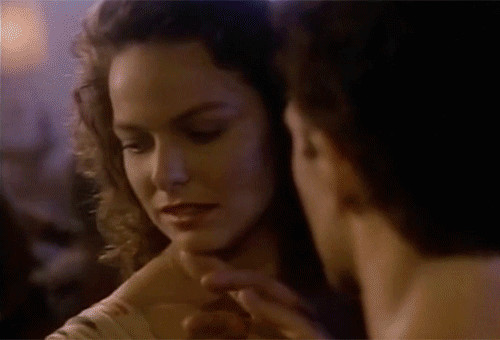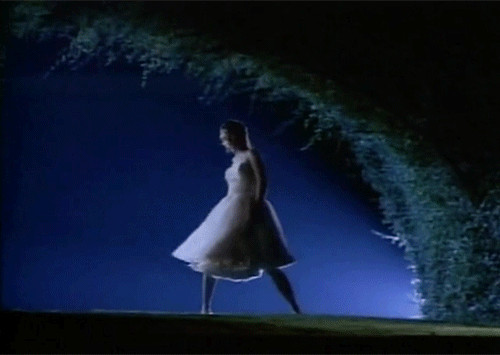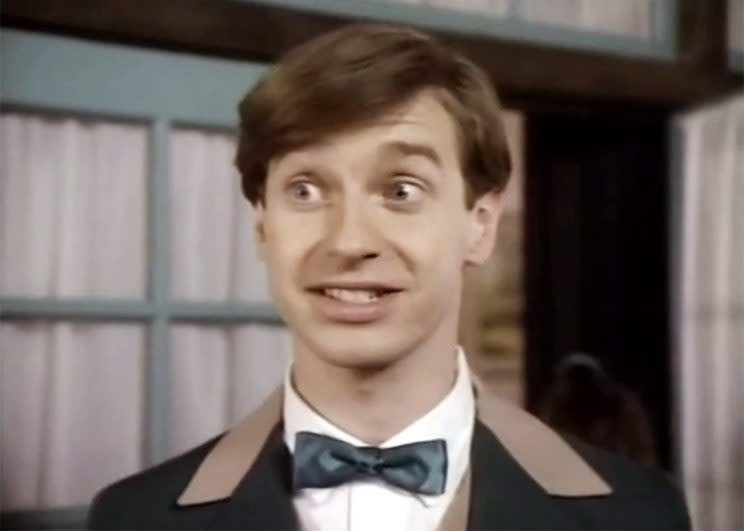While many Dirty Dancing enthusiasts are excited about revisiting Kellerman’s, it’s worth noting that this isn’t the first time television has brought us back to the beloved Catskills resort. Long before recent remakes, in 1988, just a little over a year after the original Patrick Swayze and Jennifer Grey movie became a cinematic sensation, CBS launched Dirty Dancing, a TV series.
Premiering on Saturday, October 29, 1988, this Dirty Dancing 1988 TV series starred Melora Hardin, known later for Transparent, as Baby. In this iteration, Baby is Frances Kellerman, the 18-year-old daughter of Max Kellerman (M*A*S*H‘s McLean Stevenson), the owner of Kellerman’s. The story unfolds during the summer of 1963, as Baby returns to Kellerman’s before starting at Mount Holyoke College in the fall. She seeks to reconnect with her father, from whom she had become estranged after his divorce from her mother. Initially hoping for a waitress job, Baby is instead appointed as the talent coordinator by Max. This position was previously held by Johnny Castle (Patrick Cassidy), a 23-year-old dance instructor from Jersey who works as a mechanic during the winter.
Thirty years later, Melora Hardin’s recollections of this one-season show are somewhat hazy, although she does possess a DVD collection of all episodes. She attributes her casting to producer Steve Tisch, who had previously collaborated with her on the 1986 film Soul Man with C. Thomas Howell. “I feel like he kind of just decided I was going to be Baby,” Hardin recalls, suggesting Tisch’s decisive role in her landing the part for the half-hour Dirty Dancing series.
This casting felt particularly apt because Hardin had a strong dance background. She had trained seriously in dance from a young age, even attending the Joffrey Ballet in New York on scholarship at 13. Interestingly, her connection to Dirty Dancing extended beyond the series; she had a prior link to Patrick Swayze himself. When Hardin was young, the ballet studio in Toluca Lake, California, where she trained, introduced a jazz class taught by a pre-fame Swayze. “I think he taught for at least six months or a year. Always arriving on his motorcycle,” she recounts. “I just remember the tight jeans — tight in the front and the back, I will just point out. His long ’70s hairdo. He just was so sexy and so warm and sweet. I remember being like, ‘Oh my God.’ I think my tongue was out of my mouth the entire class. What a lovely, lovely guy he was. Even then, he was with Lisa [Niemi], his wife [until his death in 2009]. They stayed together forever, and she was also a wonderful dancer and would come sometimes.”
DIrty Dancing Season 1 Episodes 1&2by y2jin99
Although Patrick Swayze wasn’t involved in the Dirty Dancing 1988 tv series, Hardin was excited about the involvement of Kenny Ortega, the choreographer from the original movie, in the TV show. However, her direct collaboration with Ortega was less than she anticipated, especially compared to Patrick Cassidy. “I was really a better dancer than Patrick [Cassidy] was. That was kind of hard for me to play down, at first,” she admits, “just because I really wanted to dance.”
Ultimately, Hardin embraced the role’s demands. In the series premiere, Johnny suggests Baby participate in the staff dance performance for an upcoming show, deliberately placing her in a rehearsal to make her feel awkward. “There’s a whole section where everyone’s dancing and I’m trying to catch the steps and I’m totally out of rhythm — everyone’s going down and I’m standing up. It’s fun when you actually do have rhythm to try not to have rhythm,” Hardin explains about portraying Baby’s initial dance struggles. The key, she found, was method acting applied to dance. “Just like anything in acting, you have to think the way the character thinks and believe what the character believes,” she says. “I think people can’t hear the rhythm because they’re in their head too much. It’s just like there’s a whole school of thought, which I think is really true, that everybody is born able to sing. The reason they can’t sing is because someone’s told them along the way that they can’t carry a tune, or they can’t sing, or they shouldn’t sing. I think it’s the same thing with dancing; everyone’s got rhythm, they just have to feel it.”
 Patrick Cassidy and Melora Hardin in Dirty Dancing 1988 TV series, Baby learning to dance
Patrick Cassidy and Melora Hardin in Dirty Dancing 1988 TV series, Baby learning to dance
Baby starts to find her rhythm. (Photo: CBS)
Baby’s dancing progresses quickly, and Hardin recalls network concerns about the level of “dirty dancing” depicted in the show. “I think it’s really the first scene where Baby and Johnny dance together. I come in, in that pretty, flowy little dress. I remember loving that dress. And the dancers were all dancers that I took classes with, and it was pretty raunchy. They were, like, in there,” she shares with a laugh. “They were grinding and dancing, and even the stuff Patrick and I did was pretty sexy.”
Despite the palpable chemistry between Baby and Johnny, including a kiss in the second episode when Johnny tries to dissuade her from leaving Kellerman’s after a disagreement with her father, Baby initially resists romantic involvement. At the end of the second episode, following her successful participation in the group dance, they are back in the staff quarters. Johnny inquires about the possibility of a relationship, but Baby responds, “I told you, all I wanted to do was learn how to dance,” leaving him somewhat rejected.
This moment of self-discovery through dance is highlighted in a scene Hardin fondly remembers. “I come out, and I’m kind of just in that kind of revelry of feeling good and dancing, and I do this big kick, and I’m wearing a beautiful dress and the dress goes up,” Hardin describes. Interestingly, unlike the movie, Hardin doesn’t recall performing the iconic lift with Cassidy in the series. She believes Constance Marie, who played Johnny’s dance partner Penny, took on that move, and notes the on-screen tension between Penny and Baby, possibly more pronounced than in the film. “They ended up dating in real life for quite some time after that,” Hardin adds about Cassidy and Marie.
 Melora Hardin as Baby in Dirty Dancing 1988 TV series, celebrating dance
Melora Hardin as Baby in Dirty Dancing 1988 TV series, celebrating dance
Baby in a moment of triumph. (Photo: CBS)
Expectations were high for the Dirty Dancing 1988 tv series. “Everyone thought this was going to be a huge series,” Hardin states. The question remains: why didn’t it achieve lasting success? “I don’t know. I remember one critic not liking that I was not ‘Jewish-looking,’ because she’s supposed to be Jewish. I don’t know if that was the thing. I mean, I think the series was good. … Who knows why these things do catch on or don’t,” she reflects. She draws a parallel to another project from early in her career, The Family Tree from 1983, created by the team behind the hit show Family. Despite its quality and pedigree, it also had a short run. “I just think the business was really different. We didn’t have things streaming, you know? Everything came out on the time that it came out, and you either watched it or you didn’t.”
 Paul Feig in Dirty Dancing 1988 TV series as Norman Bryant, the bellboy
Paul Feig in Dirty Dancing 1988 TV series as Norman Bryant, the bellboy
Paul Feig as Norman Bryant, the bellboy and aspiring comedian. (Photo: CBS)
Looking back, Hardin cherishes her experience on the Dirty Dancing 1988 tv series for the talented individuals she worked with and the friendships she formed, including with Paul Feig, later known for Freaks and Geeks and Bridesmaids, who played Norman, a bellboy and aspiring stand-up comedian. She also fondly remembers bringing her kitten to the set daily. “I had a kitten that I brought with me every day. He would ride on my dashboard to work and stay in my trailer,” she recounts. “He became the most amazing cat because he was so socialized in this really unusual way for a cat.”
Having built a successful television career since then, with notable roles in The Office and Transparent, Hardin continues to be active in the industry. She highlights the importance of seeing empowered women on screen, referencing her role as Jacqueline in The Bold Type, a series about young women in media. She emphasizes the need for diverse portrayals of women in power, moving away from stereotypical depictions. “A lot of times on television, when you have a woman of power, they’re synonymous with ‘b***hes.’ That’s how people play women of power, and that’s because it’s been such a male-dominated medium,” she observes. “I think the only way women’s stories are going to get told is for women to be telling those stories.”
The Dirty Dancing TV series from 1988, though short-lived, remains a unique chapter in the Dirty Dancing legacy. It offered Melora Hardin an early leading role and a chance to explore a beloved story in a new format. While it may not have reached the iconic status of the movie, it provided its own charm and a glimpse back into Kellerman’s, thirty years ago.
Note: The Dirty Dancing 1988-89 TV series is currently not available on DVD in the U.S.
